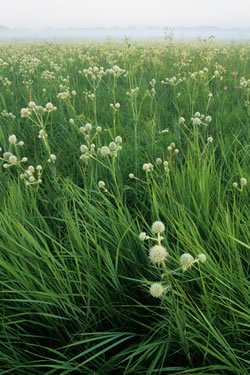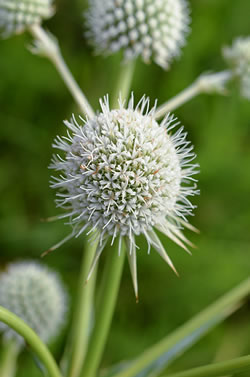Prairie Flower Series - Rattlesnake Master #4
A prairie is a temperate grassland, plains of grass that get hot in the summer and cold in the winter. Before the European settlement of North America, most of the interior was prairie. Due to the settlement, the environment was radically altered by the infusion of agriculture.
Earlier this winter, we learned about animals that live on the prairies (Parks winter caches). This series will teach us about plants that live on the prairies and most are used in flower gardens in warm areas.

Description:
Rattlesnake master thrives in full sun and has a wide range, most of the eastern United States, from southern Ontario and Florida west to Iowa, Kansas, and eastern Texas. Along the Gulf and lower Atlantic Coast, it is joined by a relative, Eryngium aquaticum, which also has monocot-like leaves. In the Midwest, rattlesnake master is a characteristic forb of tallgrass prairies, growing in a wide range of soils, but usually on calcareous, moist sites. However Rattlesnake master thrives in full sun and has a wide range, most of the eastern United States, from southern Ontario and Florida west to Iowa, Kansas, and eastern Texas. Along the Gulf and lower Atlantic Coast, it is joined by a relative, Eryngium aquaticum, which also has monocot-like leaves. Of course, the name “rattlesnake master” prompts all kinds of suggestions as to potential medical uses. The best documented use, made by John Adair during the 1700s, describes the use of the plant’s sap as a preventative to snakebite, used during ceremonial handling of rattlesnakes. The sap and roots were also used to treat a wide variety of maladies, and as a diuretic. The Mesquakies used it in their ceremonial rattlesnake dance and used the roots to treat rattlesnake bites. The bristly flower heads are arranged like a pitchfork, suggesting a possible use as a snake stick to pin down the head of a rattlesnake. There is no evidence for the efficacy of this plant in prevention or treatment of any medical condition. Native Americans would use the fibrous leaves of this perennial plant for weaving purposes, like making sandals and baskets., rattlesnake master can also occur in glades and savannas. Southeast of the prairie regions, suitable habitat for rattlesnake master includes barrens, flatwoods, and the upper edges of seeps and swamps.

This cache is located in the Onondaga Park in the village of Liverpool. This is a highly muggle area so please hide as found and beware of the muggles! Hope you enjoy the series.
This cache is a camo’d pill container. The trail is an easy flat walk by the lake! Enjoy the hike. Check for parking coords.
**Taken from www.fs.fed.us/wildflowers/plant-of-the-week/Eryngium-yuccifolium.shtml